
Eye Green is a village in the unitary authority of Peterborough, England. It lies north of Eye and south of Crowland.
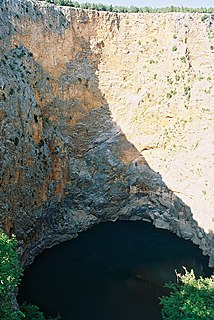
A sinkhole, also known as a cenote, sink, sink-hole, swallet, swallow hole, or doline, is a depression or hole in the ground caused by some form of collapse of the surface layer. Most are caused by karst processes – the chemical dissolution of carbonate rocks or suffosion processes. Sinkholes vary in size from 1 to 600 m both in diameter and depth, and vary in form from soil-lined bowls to bedrock-edged chasms. Sinkholes may form gradually or suddenly, and are found worldwide.
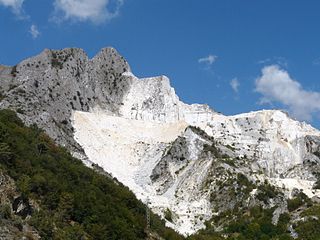
A quarry is a type of open-pit mine in which dimension stone, rock, construction aggregate, riprap, sand, gravel, or slate is excavated from the ground.

Aztalan State Park is a Wisconsin state park in the Town of Aztalan, Jefferson County, at latitude N 43° 4′ and longitude W 88° 52′. Established in 1952, it was designated a National Historic Landmark in 1964 and added to the National Register of Historic Places in 1966. The park covers 172 acres along the Crawfish River.

A defensive fighting position (DFP) is a type of earthwork constructed in a military context, generally large enough to accommodate anything from one soldier to a fire team.

In archaeology a posthole or post-hole is a cut feature used to hold a surface timber or stone. They are usually much deeper than they are wide although truncation may not make this apparent. Although the remains of the timber may survive most postholes are mainly recognisable as circular patches of darker earth when viewed in plan. Archaeologists can use their presence to plot the layout of former structures as the holes may define its corners and sides. Construction using postholes is known as earthfast or post in ground construction.
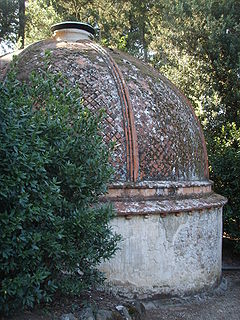
Ice houses or icehouses are buildings used to store ice throughout the year, commonly used prior to the invention of the refrigerator. Some were underground chambers, usually man-made, close to natural sources of winter ice such as freshwater lakes, but many were buildings with various types of insulation.

A dugout or dug-out, also known as a pit-house or earth lodge, is a shelter for humans or domesticated animals and livestock based on a hole or depression dug into the ground. Dugouts can be fully recessed into the earth, with a flat roof covered by ground, or dug into a hillside. They can also be semi-recessed, with a constructed wood or sod roof standing out. These structures are one of the most ancient types of human housing known to archaeologists, and the same methods have evolved into modern "earth shelter" technology.
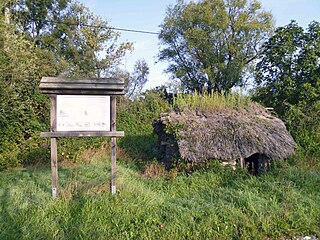
A pit-house is a building that is partly dug into the ground, and covered by a roof. Besides providing shelter from extremes of weather, these structures may also be used to store food and for cultural activities like the telling of stories, dancing, singing and celebrations. General dictionaries also describe a pit-house as a dugout, and it has similarities to a half-dugout.
A shovel test pit (STP) is a standard method for Phase I of an archaeological survey. It is usually a part of the Cultural Resources Management (CRM) methodology and a popular form of rapid archaeological survey in the United States of America and Canada.
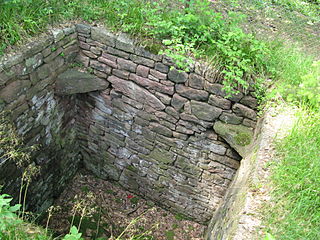
Trapping pits are deep pits dug into the ground, or built from stone, in order to trap animals. European rock drawings and cave paintings reveal that elk and moose were hunted since the stone age using trapping pits. In Northern Scandinavia one can still find remains of trapping pits used for hunting elk, reindeer, wolves and bears. These pits, which can measure up to 4 by 7 metres in size and be up to several metres deep, were camouflaged with branches and leaves. They had steep sides lined with planks or masonry, making it impossible for the animal to escape once it had fallen in. When the animal had fallen into the pit, it was killed, either bled to death by sharpened sticks pointed upwards from the bottom of the pit, or in the case of pits without these sticks, dispatched by hunters waiting nearby. Some traps had a small rope enabling rodents and amphibians to escape.

Pyhäsalmi Mine, the deepest base metal mine in Europe is located at the Pyhäjärvi municipality in the south of Northern Ostrobothnia province, Finland. The zinc and copper mine is owned by First Quantum Minerals, a Canadian mining corporation.

A well is an excavation or structure created in the ground by digging, driving, or drilling to access liquid resources, usually water. The oldest and most common kind of well is a water well, to access groundwater in underground aquifers. The well water is drawn up by a pump, or using containers, such as buckets, that are raised mechanically or by hand. Water can also be injected back into the aquifer through the well. Wells were first constructed at least eight thousand years ago and historically vary in construction from a simple scoop in the sediment of a dry watercourse to the qanats of Iran, and the stepwells and sakiehs of India. Placing a lining in the well shaft helps create stability, and linings of wood or wickerwork date back at least as far as the Iron Age.
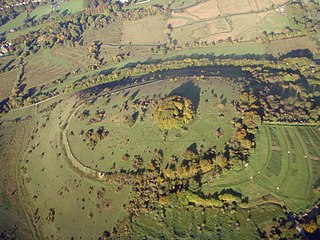
St. Catherine's Hill is a small but dramatic chalk hill to the south east of Winchester in Hampshire, England. Rising steeply some 67 metres (220 ft) from the water meadows of the River Itchen, the summit of the hill at 97 metres (318 ft) provides a fine view over Winchester.

Brede Pit and Cutting is a 0.6-hectare (1.5-acre) geological Site of Special Scientific Interest in Brede in East Sussex. It is a Geological Conservation Review site.

Timpanogos Glacier is a rock glacier or glacier that is located in the Wasatch Range, Wasatch-Cache National Forest, and is the last known glacier in the U.S. state of Utah. The glacier is situated on the north slope of Mount Timpanogos. The best evidence indicates that the Timpanogos Glacier was once a "true" glacier with crevasses present in the early 20th century, but that the surface portion was lost during the dust bowl drought of the 1930s and reduced to a permanent snowfield.

The Manchester Coalfield is part of the South Lancashire Coalfield, the coal seams of which were laid down in the Carboniferous Period. Some easily accessible seams were worked on a small scale from the Middle Ages, and extensively from the beginning of the Industrial Revolution in the early 19th century until the last quarter of the 20th century. The Coal Measures lie above a bed of Millstone Grit and are interspersed with sandstones, mudstones, shales, and fireclays. The Lower Coal Measures occupy the high ground of the West Pennine Moors above Bolton and are not worked in the Manchester Coalfield. The most productive of the coal measures are the lower two thirds of the Middle Coal Measures where coal is mined from seams between the Worsley Four Foot and Arley mines. The deepest and most productive collieries were to the south of the coalfield. The coalfield is affected by the northwest to southeast aligned Pendleton Fault along the Irwell Valley and the Rossendale Anticline. The Coal Measures generally dip towards the south and west. Numerous other smaller faults affect the coalfield. The Upper Coal Measures are not worked in the Manchester Coalfield.

The Sacred pit of Garlo is an archaeological site near the village of Garlo in Pernik District, Bulgaria.

A brick-lined well is a hand-dug water well whose walls are lined with bricks, sometimes called "Dutch bricks" if they are trapezoidal or made on site. The technique is ancient, but is still appropriate in developing countries where labor costs are low and material costs are high.

Digging, also referred to as excavation, is the process of using some implement such as claws, hands, manual tools or heavy equipment, to remove material from a solid surface, usually soil or sand on the surface of the Earth. Digging is actually the combination of two processes, the first being the breaking or cutting of the surface, and the second being the removal and relocation of the material found there. In a simple digging situation, this may be accomplished in a single motion, with the digging implement being used to break the surface and immediately fling the material away from the hole or other structure being dug.



















